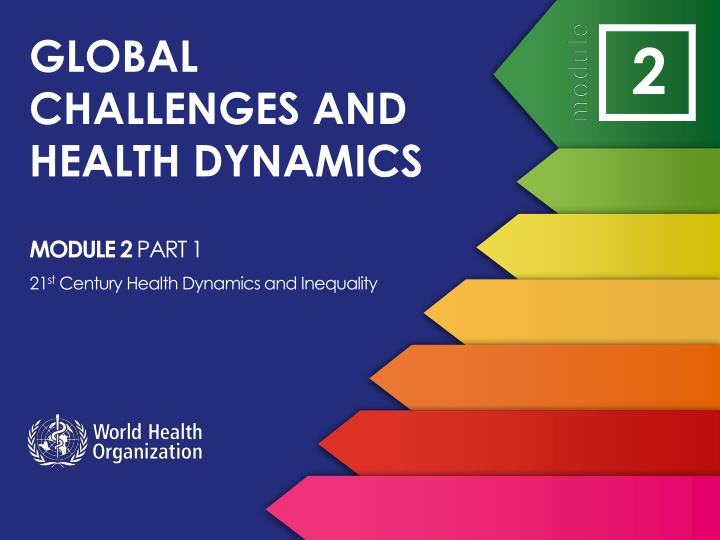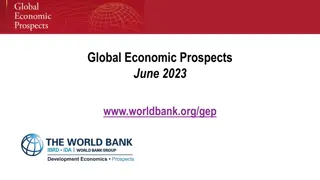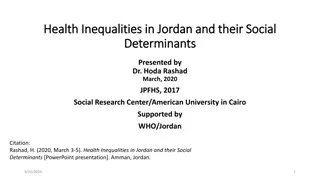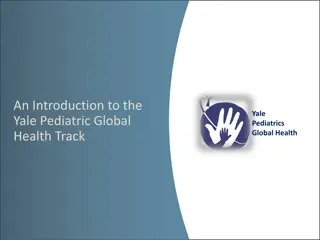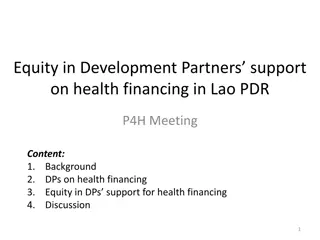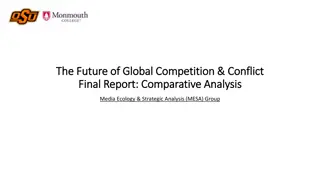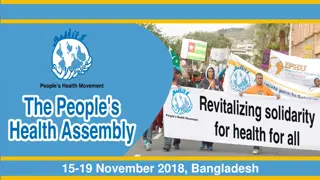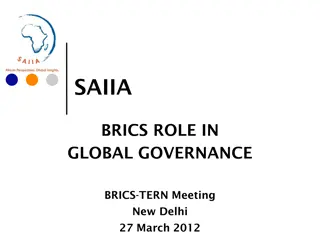GLOBAL CHALLENGES AND HEALTH DYNAMICS
Examining global challenges impacting health dynamics in the 21st century, including globalization, urbanization, poverty, and environmental degradation. Explore how trade, migration, and industrialization influence health outcomes in our rapidly urbanizing world.
Download Presentation

Please find below an Image/Link to download the presentation.
The content on the website is provided AS IS for your information and personal use only. It may not be sold, licensed, or shared on other websites without obtaining consent from the author.If you encounter any issues during the download, it is possible that the publisher has removed the file from their server.
You are allowed to download the files provided on this website for personal or commercial use, subject to the condition that they are used lawfully. All files are the property of their respective owners.
The content on the website is provided AS IS for your information and personal use only. It may not be sold, licensed, or shared on other websites without obtaining consent from the author.
E N D
Presentation Transcript
GLOBAL CHALLENGES AND HEALTH DYNAMICS 2 MODULE 2 PART 1 21st Century Health Dynamics and Inequality
LEARNING OBJECTIVES 2 Describe some of the major global challenges impacting health 1
2 GLOBAL CHALLENGES FOR HEALTH The 21st century brings many complex and interacting challenges. Some of the major global challenges directly and indirectly impacting health include: Globalization 1 Urbanization 2 Poverty 3 Socioeconomic inequality 4 Food insecurity 5 6 Environmental degradation Demographic transition 7
GLOBALIZATION: TRADE, MIGRATION AND INDUSTRIALIZATION 2 1 The world is more and more economically interconnected. Trade between countries is one indication of this. Between 1960 and 2017, the value of trade in goods and services as a share of global GDP increased from 12% to 37%.1 The number of people travelling and migrating is increasing. 1 World Bank, World Development Indicators. Accessed https://data.worldbank.org/indicator/NE.EXP.GNFS.ZS
GLOBALIZATION: TRADE, MIGRATION AND INDUSTRIALIZATION 2 1 Many low- and middle-income economies have industrialized and grown significantly. Consequences for rural to urban migration, urbanization and socioeconomic change. This globalization is impacting health in multiple ways: Increases risks of global epidemics such as severe acute respiratory syndrome (SARs) and the spread of health hazards including contaminated foods and products; Rapid economic growth places pressure on the labour force, infrastructure and environment.
URBANIZATION 2 2 Urbanization is the process of the population moving from rural areas to urban areas, which leads to many changes in economic, social and physical environments. The world is rapidly becoming more urban. Between 2010 and 2050, the percentage of the world s population living in urban areas is predicted to increase from 50% to 70%. At present, nearly 1 billion people or 33% of the urban population live in slums.
URBANIZATION 2 2 As with rapid economic growth, urbanization can place strain on infrastructure resulting in poor living conditions and an inability to properly access social services like education and medical care. Rapid, unplanned urbanization creates congestion and pollution, and has impacts on health-promoting behaviours and risk factors for non-communicable diseases (NCDs).
ECONOMIC GROWTH, POVERTY AND GOVERNANCE 2 3 Economic growth is the most powerful instrument for reducing poverty and improving quality of life. In 2015, 736 million people lived on less than $1.90 a day, down from 1.85 billion in 1990.2 While poverty rates have declined in all regions, progress has been uneven. Increasingly, the majority of the world s poor live in middle-income countries. 2 The World Bank, Understanding Poverty, accessed (page updated Apr 03, 2019): https://www.worldbank.org/en/topic/poverty/overview
ECONOMIC GROWTH, POVERTY AND GOVERNANCE 2 3 Health is traditionally viewed as an end product of the growth process. However, in the other direction, a healthy population is also a driver for economic growth. In many countries, the past several decades of economic growth have been accompanied by a shift in the discourse of public policy and governance towards neoliberalism.
SOCIOECONOMIC INEQUALITY 2 4 Interrelated to poverty, there is also socioeconomic inequality. Socioeconomic inequality relates to disparities in both economic and social resources. Large inequalities exist not only across countries, but also between population groups within each country.
SOCIOECONOMIC INEQUALITY 2 4 Growth in many countries has disproportionally benefited higher income groups while lower income households have been left behind. Income and wealth inequalities are fundamental causes of health inequalities. They influence other factors such as housing, alcohol use and smoking.
SOCIOECONOMIC INEQUALITY 2 INEQUALITIES ARE ON THE RISE AND HALTING THIS TREND HAS BECOME A PRIORITY FOR POLICY-MAKERS IN MANY COUNTRIES. Global Income Inequality Inequality is Rising or Staying Extremely High Nearly Everywhere Top 10% income shares across the world, 1980-2016 Africa Brazil China Europe 60 Share of National Income (%) India Middle-East 50 Russia US-Canada 40 30 20 1980 1985 1990 1995 2000 2005 2010 2015 Source: World Inequality Lab, World Inequality Report, 2018
SOCIOECONOMIC INEQUALITY 2 RISING INCOME INEQUALITY CHANGE IN REAL HOUSEHOLD INCOME, OECD AVERAGE The gap between low income and high income earners keeps on increasing over the years Top 10% 40% Bottom 40% 20% Bottom 10% 0% 1980 1985 1990 1995 2000 2005 2010 Source: In It Together - Why Less Inequality Benefits All (2015)
FOOD INSECURITY 2 5 Food security exists when all people at all times have physical, social and economic access to sufficient, safe and nutritious food to meet dietary needs and food preferences for an active and healthy life. New shocks related to climate change, conflict, pests (such as locusts) and infectious diseases are hurting food production, disrupting supply chains and stressing people s ability to access nutritious and affordable food.
FOOD INSECURITY 2 5 The widespread incidence of microbiological, chemical or other food safety hazards in food also continues to be a serious issue for the food system. Recent world economic reports have highlighted economic slowdowns and downturns in several economies, impacting global food security and nutrition trends.
ENVIRONMENTAL DEGRADATION 2 6 Conserving the earth s ecosystem on which human society depends is a precondition for economic and social development, including good health. Although human health has improved dramatically since 1950, this gain has been accompanied by unprecedented environmental degradation from human activities that now threaten both human health and life-support systems.
ENVIRONMENTAL DEGRADATION 2 6 Environmental factors polluted air, built environment hazards, agricultural practices, occupational hazards, radiation, climate change, chemical exposures and inadequate water and sanitation were associated with 12.6 million deaths (23% of deaths worldwide) in 2012.3 3 Pr ss-Ust n, A, Wolf, J, Corval n, C, Bos, R & Neira, M 2016, Preventing disease through healthy environments: a global assessment of the burden of disease from environmental risks, WHO, Geneva.
ENVIRONMENTAL DEGRADATION 2 GLOBAL IMPACTS ON HEALTH OF THE PLANET AND HUMAN HEALTH, 2018 50. Household or urban pollution and greenhouse gases Interconnectedness of Earth system Air Greatest cause of death and sickness; causes displacement globally globally. Desertification, deforestation, and chemical pollution Socioecological systems Land Impact on access to land, number of jobs Pollution (including antibiotics or nano), extraction greater than recharge Freshwater Impact on water security, health and jobs Fish population declines, plastic pollution, coral bleaching, polar ice melting Oceans Loss of cheap protein and jobs Pollinators decline; extinction of genes, species, or ecosystems Biodiversity Food security decrease, potential zoonoses increase Planetary Impact Good Stable Reversible Irreversible Human Health Impact Low Source: Gupta, J et al. (2019). Communicating the health of the planet and its links to human health. The Lancet, Planetary Health, DOI:https://doi.org/10.1016/S2542-5196(19)30040-3.
DEMOGRAPHIC TRANSITION 2 7 Demographic transition is the transition from high birth and death rates to lower birth and death rates as a country or region develops from an agricultural society to an industrialized economic system. Population growth: according to the United Nations, the global population is predicted to increase from 6.8 billion to 9.1 billion between 2010 and 2050.
DEMOGRAPHIC TRANSITION 2 7 Other demographic processes undergoing change include women s fertility and increasingly older populations in the developed world. This demographic transition places strain on the health care system as more people need care, especially for chronic illnesses such as NCDs.
End of Module 2 Part 1 Please continue to Module 2 Part 2
